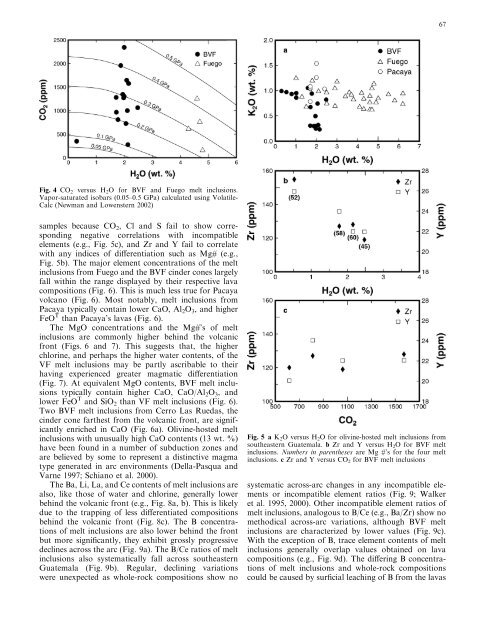The water and trace element contents of melt - Department of ...
The water and trace element contents of melt - Department of ...
The water and trace element contents of melt - Department of ...
Create successful ePaper yourself
Turn your PDF publications into a flip-book with our unique Google optimized e-Paper software.
Fig. 4 CO2 versus H2O for BVF <strong>and</strong> Fuego <strong>melt</strong> inclusions.<br />
Vapor-saturated isobars (0.05–0.5 GPa) calculated using Volatile-<br />
Calc (Newman <strong>and</strong> Lowenstern 2002)<br />
samples because CO 2, Cl <strong>and</strong> S fail to show corresponding<br />
negative correlations with incompatible<br />
<strong>element</strong>s (e.g., Fig. 5c), <strong>and</strong> Zr <strong>and</strong> Y fail to correlate<br />
with any indices <strong>of</strong> differentiation such as Mg# (e.g.,<br />
Fig. 5b). <strong>The</strong> major <strong>element</strong> concentrations <strong>of</strong> the <strong>melt</strong><br />
inclusions from Fuego <strong>and</strong> the BVF cinder cones largely<br />
fall within the range displayed by their respective lava<br />
compositions (Fig. 6). This is much less true for Pacaya<br />
volcano (Fig. 6). Most notably, <strong>melt</strong> inclusions from<br />
Pacaya typically contain lower CaO, Al 2O 3, <strong>and</strong> higher<br />
FeO T than Pacaya’s lavas (Fig. 6).<br />
<strong>The</strong> MgO concentrations <strong>and</strong> the Mg#’s <strong>of</strong> <strong>melt</strong><br />
inclusions are commonly higher behind the volcanic<br />
front (Figs. 6 <strong>and</strong> 7). This suggests that, the higher<br />
chlorine, <strong>and</strong> perhaps the higher <strong>water</strong> <strong>contents</strong>, <strong>of</strong> the<br />
VF <strong>melt</strong> inclusions may be partly ascribable to their<br />
having experienced greater magmatic differentiation<br />
(Fig. 7). At equivalent MgO <strong>contents</strong>, BVF <strong>melt</strong> inclusions<br />
typically contain higher CaO, CaO/Al 2O 3, <strong>and</strong><br />
lower FeO T <strong>and</strong> SiO 2 than VF <strong>melt</strong> inclusions (Fig. 6).<br />
Two BVF <strong>melt</strong> inclusions from Cerro Las Ruedas, the<br />
cinder cone farthest from the volcanic front, are significantly<br />
enriched in CaO (Fig. 6a). Olivine-hosted <strong>melt</strong><br />
inclusions with unusually high CaO <strong>contents</strong> (13 wt. %)<br />
have been found in a number <strong>of</strong> subduction zones <strong>and</strong><br />
are believed by some to represent a distinctive magma<br />
type generated in arc environments (Della-Pasqua <strong>and</strong><br />
Varne 1997; Schiano et al. 2000).<br />
<strong>The</strong> Ba, Li, La, <strong>and</strong> Ce <strong>contents</strong> <strong>of</strong> <strong>melt</strong> inclusions are<br />
also, like those <strong>of</strong> <strong>water</strong> <strong>and</strong> chlorine, generally lower<br />
behind the volcanic front (e.g., Fig. 8a, b). This is likely<br />
due to the trapping <strong>of</strong> less differentiated compositions<br />
behind the volcanic front (Fig. 8c). <strong>The</strong> B concentrations<br />
<strong>of</strong> <strong>melt</strong> inclusions are also lower behind the front<br />
but more significantly, they exhibit grossly progressive<br />
declines across the arc (Fig. 9a). <strong>The</strong> B/Ce ratios <strong>of</strong> <strong>melt</strong><br />
inclusions also systematically fall across southeastern<br />
Guatemala (Fig. 9b). Regular, declining variations<br />
were unexpected as whole-rock compositions show no<br />
67<br />
Fig. 5 a K2O versus H2O for olivine-hosted <strong>melt</strong> inclusions from<br />
southeastern Guatemala. b Zr <strong>and</strong> Y versus H2O for BVF <strong>melt</strong><br />
inclusions. Numbers in parentheses are Mg #’s for the four <strong>melt</strong><br />
inclusions. c Zr <strong>and</strong> Y versus CO2 for BVF <strong>melt</strong> inclusions<br />
systematic across-arc changes in any incompatible <strong>element</strong>s<br />
or incompatible <strong>element</strong> ratios (Fig. 9; Walker<br />
et al. 1995, 2000). Other incompatible <strong>element</strong> ratios <strong>of</strong><br />
<strong>melt</strong> inclusions, analogous to B/Ce (e.g., Ba/Zr) show no<br />
methodical across-arc variations, although BVF <strong>melt</strong><br />
inclusions are characterized by lower values (Fig. 9c).<br />
With the exception <strong>of</strong> B, <strong>trace</strong> <strong>element</strong> <strong>contents</strong> <strong>of</strong> <strong>melt</strong><br />
inclusions generally overlap values obtained on lava<br />
compositions (e.g., Fig. 9d). <strong>The</strong> differing B concentrations<br />
<strong>of</strong> <strong>melt</strong> inclusions <strong>and</strong> whole-rock compositions<br />
could be caused by surficial leaching <strong>of</strong> B from the lavas

















